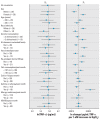Mercury induces an unopposed inflammatory response in human peripheral blood mononuclear cells in vitro
- PMID: 20049214
- PMCID: PMC2799469
- DOI: 10.1289/ehp.0900855
Mercury induces an unopposed inflammatory response in human peripheral blood mononuclear cells in vitro
Abstract
Background: The human immune response to mercury is not well characterized despite the body of evidence that suggests that Hg can modulate immune responses, including the induction of autoimmune disease in some mouse models. Dysregulation of cytokine signaling appears to play an important role in the etiology of Hg-induced autoimmunity in animal models.
Objectives: In this study, we systematically investigated the human immune response to Hg in vitro in terms of cytokine release.
Methods: Human peripheral blood mononuclear cells (PBMCs) were isolated from 20 volunteers who donated blood six separate times. PBMCs were cultured with lipopolysaccharide and concentrations of mercuric chloride (HgCl(2)) up to 200 nM. Seven cytokines representing important pathways in physiologic and pathologic immune responses were measured in supernatants. We used multilevel models to account for the intrinsic clustering in the cytokine data due to experimental design.
Results: We found a consistent increase in the release of the proinflammatory cytokines interleukin-1beta (IL-1beta) and tumor necrosis factor-alpha, and concurrent decrease in release of the antiinflammatory cytokines interleukin 1-receptor antagonist (IL-1Ra) and IL-10 in human PBMCs treated with subcytotoxic concentrations of HgCl(2). IL-4, IL-17, and interferon-gamma increased in a concentration-response manner. These results were replicated in a second, independently recruited population of 20 different volunteers.
Conclusions: Low concentrations of HgCl(2) affect immune function in human cells by dysregulation of cytokine signaling pathways, with the potential to influence diverse health outcomes such as susceptibility to infectious disease or risk of autoimmunity.
Keywords: immunotoxicity; inflammation; mercury; multilevel modeling.
Figures


References
-
- Alves MF, Fraiji NA, Barbosa AC, De Lima DS, Souza JR, Dorea JG, et al. Fish consumption, mercury exposure and serum antinuclear antibody in Amazonians. Int J Environ Health Res. 2006;16(4):255–262. - PubMed
-
- Apostolakis S, Vogiatzi K, Krambovitis E, Spandidos DA. IL-1 cytokines in cardiovascular disease: diagnostic, prognostic and therapeutic implications. Cardiovasc Hematol Agents Med Chem. 2008;6(2):150–158. - PubMed
-
- Arend WP. The balance between IL-1 and IL-1Ra in disease. Cytokine Growth Factor Rev. 2002;13(4–5):323–340. - PubMed
-
- Arnett FC, Reveille JD, Goldstein R, Pollard KM, Leaird K, Smith EA, et al. Autoantibodies to fibrillarin in systemic sclerosis (scleroderma). An immunogenetic, serologic, and clinical analysis. Arthritis Rheum. 1996;39(7):1151–1160. - PubMed
Publication types
MeSH terms
Substances
Grants and funding
LinkOut - more resources
Full Text Sources
Medical

